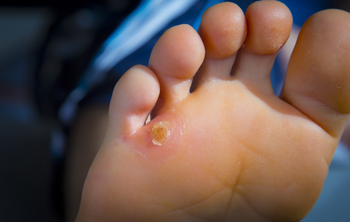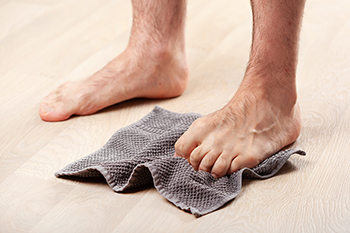October 2022
Plantar Fasciitis and Driving

Plantar fasciitis is an extremely common type of heel pain that can develop in an individual when the plantar fascia, a band of tissue in the arch of the foot, becomes inflamed. Many different physical activities can cause plantar fasciitis. One of these overlooked causes can be driving repeatedly. Someone who is constantly driving may be increasing their susceptibility to plantar fasciitis in their right foot because this foot is needed to constantly press on and off of the gas and brake pedals. This repeated flexing of the foot is known as plantar flexion, and may exacerbate your plantar fasciitis. If you are an excessive driver, there are steps that you might consider taking to mitigate your foot condition. For example, you might be intentional about taking several breaks during car rides so that you may fully stretch your feet and legs. Contact a podiatrist today for more information.
Plantar fasciitis can be very painful and inconvenient. If you are experiencing heel pain or symptoms of plantar fasciitis, contact John McGhan, DPM from Gold Canyon Foot & Ankle. Our doctor can provide the care you need to keep you pain-free and on your feet.
What Is Plantar Fasciitis?
Plantar fasciitis is the inflammation of the thick band of tissue that runs along the bottom of your foot, known as the plantar fascia, and causes mild to severe heel pain.
What Causes Plantar Fasciitis?
- Excessive running
- Non-supportive shoes
- Overpronation
- Repeated stretching and tearing of the plantar fascia
How Can It Be Treated?
- Conservative measures – anti-inflammatories, ice packs, stretching exercises, physical therapy, orthotic devices
- Shockwave therapy – sound waves are sent to the affected area to facilitate healing and are usually used for chronic cases of plantar fasciitis
- Surgery – usually only used as a last resort when all else fails. The plantar fascia can be surgically detached from the heel
While very treatable, plantar fasciitis is definitely not something that should be ignored. Especially in severe cases, speaking to your doctor right away is highly recommended to avoid complications and severe heel pain. Your podiatrist can work with you to provide the appropriate treatment options tailored to your condition.
If you have any questions please feel free to contact our office located in Gold Canyon, AZ . We offer the newest diagnostic and treatment technologies for all your foot and ankle needs.
Differences Between Corns and Calluses on the Feet

Some people use the terms corns and calluses interchangeably, but they are different. A corn is a small, well-defined area of thickened skin that has a hard center core and is surrounded by inflamed skin. It can develop on various parts of the foot, from the sole to the pinky toe, tops of the toes, and between toes. Corns typically develop to protect the skin from excess pressure or friction, often from ill-fitting shoes. Usually, a corn is painful when pressed. A callus is generally not painful when pressed and covers a wider area developing where the feet bear a lot of weight, like the soles. It consists of thick, hard skin throughout the affected area and may not have a defined shape. If you have corns or calluses, it is a good idea to consult with a podiatrist who can provide treatment options for both conditions.
Corns can make walking very painful and should be treated immediately. If you have questions regarding your feet and ankles, contact John McGhan, DPM of Gold Canyon Foot & Ankle. Our doctor will treat your foot and ankle needs.
Corns: What Are They? And How Do You Get Rid of Them?
Corns are thickened areas on the skin that can become painful. They are caused by excessive pressure and friction on the skin. Corns press into the deeper layers of the skin and are usually round in shape.
Ways to Prevent Corns
There are many ways to get rid of painful corns such as:
- Wearing properly fitting shoes that have been measured by a professional
- Wearing shoes that are not sharply pointed or have high heels
- Wearing only shoes that offer support
Treating Corns
Although most corns slowly disappear when the friction or pressure stops, this isn’t always the case. Consult with your podiatrist to determine the best treatment option for your case of corns.
If you have any questions please feel free to contact our office located in Gold Canyon, AZ . We offer the newest diagnostic and treatment technologies for all your foot and ankle needs.
Foot Injuries for Tennis Players

Sometimes, playing a particular sport can put an individual at a greater risk of developing certain foot conditions, and tennis is certainly no exception. Playing tennis can cause foot injuries because it is particularly demanding on the feet—a tennis player must be constantly stopping and starting movement. Additionally, specific kinds of tennis courts can have very hard surfaces. If you play tennis, you could potentially develop heel pain when excessively training. A common condition is known as plantar fasciitis, the inflammation of the plantar fascia in the arch of the foot. You could also develop what is known as sesamoiditis. This condition occurs when the sesamoid bones in the ball of the feet beneath the big toe joint become inflamed. Other tennis-related injuries include Achilles tendonitis, stress fractures, and ankle sprains. If you play tennis, contact a podiatrist for treatment and more information.
Sports related foot and ankle injuries require proper treatment before players can go back to their regular routines. For more information, contact John McGhan, DPM of Gold Canyon Foot & Ankle. Our doctor can provide the care you need to keep you pain-free and on your feet.
Sports Related Foot and Ankle Injuries
Foot and ankle injuries are a common occurrence when it comes to athletes of any sport. While many athletes dismiss the initial aches and pains, the truth is that ignoring potential foot and ankle injuries can lead to serious problems. As athletes continue to place pressure and strain the area further, a mild injury can turn into something as serious as a rupture and may lead to a permanent disability. There are many factors that contribute to sports related foot and ankle injuries, which include failure to warm up properly, not providing support or wearing bad footwear. Common injuries and conditions athletes face, including:
- Plantar Fasciitis
- Plantar Fasciosis
- Achilles Tendinitis
- Achilles Tendon Rupture
- Ankle Sprains
Sports related injuries are commonly treated using the RICE method. This includes rest, applying ice to the injured area, compression and elevating the ankle. More serious sprains and injuries may require surgery, which could include arthroscopic and reconstructive surgery. Rehabilitation and therapy may also be required in order to get any recovering athlete to become fully functional again. Any unusual aches and pains an athlete sustains must be evaluated by a licensed, reputable medical professional.
If you have any questions please feel free to contact our office located in Gold Canyon, AZ . We offer the newest diagnostic and treatment technologies for all your foot and ankle needs.
Arthritis Can Cause Pain in the Feet and Ankles
Stretching for Standing All Day

Sometimes due to one’s profession or lifestyle, an individual may be expected to stand for prolonged periods of time without otherwise moving or engaging in physical activities. This static position has its own risks of potential health problems, including lower back pain, foot pain, and achy knees. One way to address the problem of standing in a static position for long periods of time is to stretch because stretching can reduce tension in the muscles. For example, to reduce tension caused from standing, you may choose to perform the standing lunge calf stretch. This can be done by standing in front of a wall, putting one’s hands against the wall, and then repeatedly moving one foot behind the other in a lunge position. You ought to feel a stretch in the calf. This should be repeated on both feet. If you want to learn more about how stretching can address problems caused by standing all day, contact a podiatrist.
Stretching the feet is a great way to prevent injuries. If you have any concerns with your feet consult with John McGhan, DPM from Gold Canyon Foot & Ankle. Our doctor will assess your condition and provide you with quality foot and ankle treatment.
Stretching the Feet
Being the backbone of the body, the feet carry your entire weight and can easily become overexerted, causing cramps and pain. As with any body part, stretching your feet can serve many benefits. From increasing flexibility to even providing some pain relief, be sure to give your feet a stretch from time to time. This is especially important for athletes or anyone performing aerobic exercises, but anyone experiencing foot pain or is on their feet constantly should also engage in this practice.
Great ways to stretch your feet:
- Crossing one leg over the others and carefully pull your toes back. Do 10-20 repetitions and repeat the process for each foot
- Face a wall with your arms out and hands flat against the wall. Step back with one foot and keep it flat on the floor while moving the other leg forward. Lean towards the wall until you feel a stretch. Hold for 30 seconds and perform 10 repetitions for each foot
- Be sure not to overextend or push your limbs too hard or you could risk pulling or straining your muscle
Individuals who tend to their feet by regular stretching every day should be able to minimize foot pain and prevent new problems from arising.
If you have any questions, please feel free to contact our office located in Gold Canyon, AZ . We offer the newest diagnostic and treatment technologies for all your foot care needs.
